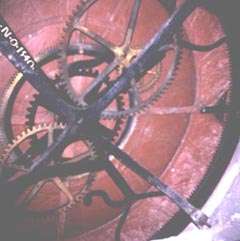
from the inside
Hampton Court Clock

There was a clock tower near the position of the present clock at Hampton Court since about 1478. This was when it was owned by the Knights Hospitallers. In 1514, Thomas Wolsey, then Bishop of Lincoln, soon to be Archbishop of York, rented the estate on a 99-year lease which allowed for rebuilding. The Abbot of the Knights of St. John gave Wolsey the hour bell, still in use today.
Wolsey was forced to hand over Hampton Court and other possessions to King Henry VIII.
The present clock tower and gateway was rebuilt by John Molton the King's Master Mason in 1528, and was named after Anne Boleyn as it was then she became the King's mistress. At the same time John Molton was also rebuilding St.James Palace a former leper hospital for women, and the main gateway and clock are very similar.
Life at Hampton Court was rather interesting at this time. Before Henry VIII decided to make Anne Boleyn his second wife, he had a relationship with her sister Mary. Mary was married to one of the King's companions William Carey, and had a daughter, then a son Henry in 1526. Both possibly the King's children. Soon after her husband died. But her sister Anne Boleyn had just taken over as the King's mistress. Also at the court was a former mistress, the mother of the King's son, Henry Fitzroy. His mother, was originally Elizabeth Blount, a 12 year old maid of honour to Queen Katherine, when Henry VIII first become interested in her. A few years after the birth of their son she was married off to Gilbert Tailboys, and lived at South Kyme, Lincolnshire. Her son was made Duke of Richmond and Somerset, and given equal status to the King's legitimate daughter Princess Mary. Known as the "Mother of the King's Son", Lady Tailboys was back at court with her daughter and two younger sons, when her husband had to attend Parliament, and remained after he died. Her two sons now lived with their brother who was now back at the court too. Since Henry VIII had decided to divorce Katherine he could have his illegimate son with him, treated as a royal prince.
Anne Boleyn was not happy at that. Henry VIII's son had stayed in France with the 2 older French princes who were about his age, while Anne had her coronation in England. He was justified in being in fear of his life. Anne had sent her brother George to the French court as the Pope was expected with his ward Catherine d'Medici who was to be married to the King's second son Henri. But the Pope stayed away. And George left suddenly leaving all his luggage and servants. In Richmond's room, his friend (and future brother in law), the Earl of Surrey found a fresh cup of wine. Which he shared with Richmond. They were both very ill but survived.
Henry VIII was still officially married to Katherine, but Anne was given a magnificent coronation in June 1533. Three months later she gave birth to Princess Elizabeth. Meanwhile ex-Queen Katherine had been moved away from the court and forbidden contact with her daughter Princess Mary.
If the King had to marry again, many people thought, what better than to marry the mother of his own son. And she was now an attractive young widow, her two younger sons now living with their brother, her daughter also possibly fathered by Henry VIII. In 1534, Anne conspired with her sister-in-law (George's wife Jane) to get rid of Elizabeth. Marriage to Elizabeth would have made their son legitimate and the King's heir.
Anne's strategies worked. Elizabeth went home to South Kyme in Lincolnshire and married Edward Clinton, younger than her but their lands adjoined. Henry VIII's son still the king's only son, returned to England and was married to Anne Boleyn's cousin Mary Howard, sister of his friend the Earl of Surrey. Anne was happy, her potential enemies had been deactivated and she was pregnant. She had a medal made with her portrait and new motto "The Most Happi".
It did not last. There was no new baby. Henry VIII started a new relationship with Jane Seymour who he met on the summer progress, and arranged for her to come to the court, and he also had affairs with two of Anne's cousins.
More about this on the website at Tudor Bastard.
Anne's signature badge of a falcon trampling over 4 Tudor roses has survived under the arches of the clock tower. Most of them in the palace were replaced with Jane Seymour's badge of a phoenix extending protective wings over 4 Tudor roses.
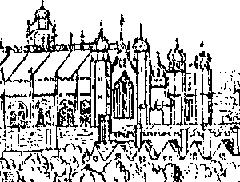 The Clock Tower forms the entrance to the Great Hall and the inner part of the palace. There are four corner turrets. As you approach from the outer courtyard, the turret on the left is the weights tower, and the belfry with the large hour bell was above this. On the other side is the jakes tower. This had a loo on each floor. The remains of these still exist. On the lower floors they were updated to serve the Grace and Favour apartments, and at the top by the present clock is the blocked off remains of the toilet once used by the guards patrolling what was originally a flat roof.
The Clock Tower forms the entrance to the Great Hall and the inner part of the palace. There are four corner turrets. As you approach from the outer courtyard, the turret on the left is the weights tower, and the belfry with the large hour bell was above this. On the other side is the jakes tower. This had a loo on each floor. The remains of these still exist. On the lower floors they were updated to serve the Grace and Favour apartments, and at the top by the present clock is the blocked off remains of the toilet once used by the guards patrolling what was originally a flat roof. The two towers at the corners of the other side both have spiral staircases which led to the clock room and to the roof.
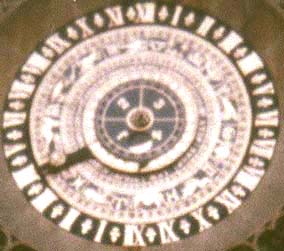 The clock has two dials, one facing the outer courtyard, and the astronomical dial on the inside.
The clock has two dials, one facing the outer courtyard, and the astronomical dial on the inside.
Details of the astronomical dial and how to read it are in the book "Inside the Hampton Court Clock" now a free download. The copper clock dial we see today appears to have been part of the clock as installed by Wren. An earlier astronomical dial may date from at least 1528. The accounts show that the clock was originally built with two dials and that it needed frequent repairs. 16th century discriptions indicate that the dial was very different to, and more colourful than, the one we see today, and probably made from wood.
14th February, 1532, John Fitzwater is first mentioned as Keeper of the Clock at Hampton Court in Henry VIII's accounts. It is not clear when he was first appointed. Fitzwater came from a clockmaking dynasty in Devon, responsible for many generations for the famous astronomical clock in Exeter Cathedral. Fitzwater had been Clockmaker to Henry VIII from 1530, and was to make a number of clocks for the King's palaces.
The Hampton Court clock was not his best. Other clockmakers, and the King's Astronomer, Nicolas Kratzer who specialized in sundials (and could drink the King under the table) were consulted.
In 1538 John Fitzwater was transfered to be Keeper of the Clock at the Palace of Newhall Boreham in Essex. This was demotion. Newhall was no longer used by the King (he used to visit his son Henry Fitzroy and the child's mother Elizabeth Blount from there) - it now belonged to the King's daughter Mary.
Fitzwater's pay was cut too, from 27 shillings and 8 pence (about £1 40p) to 13 shillings and 4 pence every three months.
Oursian was a French clockmaker, first mentioned in the King's accounts 22nd May 1532 "for stuf made for the Kings Grace" for which he was paid seven pounds and three shillings.
Oursian was appointed King's clockmaker and Keeper of the clock as successor to John Fitzwater. On 12th Mary 1541, papers for denisation (British citizenship) were delivered to his home in Westminster. Oursian is mentioned living in Westminster in 1568, with two assistants, Lawrence Daunton who was French, and Peter Doute who was Dutch. Oursian was Keeper of the Clocks at the palaces of Oatlands and Westminster as well as Hampton Court until 1590.
It was also lower down in the clock tower - about where the upper front and back windows are today. The clock court was then called the fountain court. It had lawns, flowerbeds and a trick fountain that could be triggered to shoot a surprise jet up a farthingale. It was a place of recreation for guests staggering out of a royal banquet and entertainment in the Great Hall to get some air, and the clock was part of the entertainment.
When William and Mary were brought over from Holland to take over the English throne, they had to leave behind their new palace of Het Loo. Both had quite different interests and preferred the company of their own sex. They designed Het Loo as a pair of semis, each had their own side of the palace and garden. They now intended to do the same to Hampton Court and called in astronomer Christopher Wren (now more famous as an architect).
Work began immediately on twin separate state apartments so they did not have to live together.
Fortunately for Hampton Court, both monarchs died before the rebuilding was complete and since they had not paid any bills, the project was abandoned by Queen Anne.
Anne's husband, Prince George of Denmark, who as Lord Admiral was interested in longitude and time-keeping, did want Wren to finish his project for the clock. In 1707, Wren, by then aged 75, presented his designs for the clock to Prince George and Queen Anne. Prince George died the following year, but his wife continued with the project. Wren had a house at Hampton Court so he could oversee the work personally.
The Queen's Clockmaker William Herbert had given the Hampton Court clock a complete overhaul and restoration about 1711 or just before. But Sir Christopher Wren wanted Langley Bradley, a clockmaker in Fenchurch Street, London, to make a completely new clock to run the astronomical dial which would be repainted to suit the new baroque decor.
Wren rebuilt the upper floor and roof to make the belfry we see today to house the hour bell and two smaller bells for the quarter hours. Wren's alterations made the new clock room extremely difficult and dangerous of access. It is impossible to stand up and cables threaten to trip you in the dark down the unprotected weights shaft. No one seems to have wanted to stay long enough to keep it clean. It is full of the debris of ages, rubbish left by those coming to wind, or fix, or renovate the clock, and the remains of mice and birds that became trapped in there. The alterations block access to one of the stairs, and also to the toilet that once served the guards on the roof.
| We were able to take a photo of the remains of this Tudor loo through a hole in the door. It was filled with junk left by Wren's workmen, and the pewter pan and wooden seat are missing. | 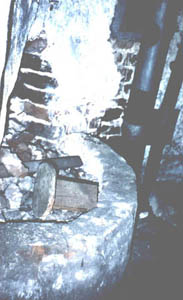 |
In 1711 Wren wrote to the Lord Chamberlain's Office to ask for Herbert to be replaced by Bradley as Queen's Clockmaker. He claimed Herbert was unfit for the job as he had become bankrupt. This was very unfair since Herbert's financial problems were due to him not being paid by his royal clients.
The Lord Chamberlain's Officer replied that the Queen's clockmaker was appointed by warrant to deal with Her Majesty's clocks, and the Office of Works was not entitled to consider that turrett clocks came under their provenance merely because they happened to be part of a building.
Langley Bradley had worked for Wren on many other projects the most famous of which was the clock in the new St. Paul's Cathedral. Official opposition to Bradley was justified by the fact that Bradley's clock at St. Paul's had been a costly failure, resulting in years of acrimonious dispute, pamphlets, accusations of fraud, and a government commisssion under the chairmanship of Sir Isaac Newton. Langley Bradley's clock at St.Paul's was scrapped and replaced with a new sturdier and safer machine commissioned from Wright and Street, which lasted until 1892.
William Derham, a friend of Langley Bradley, visited the clock in 1711, to describe it in a revised edition of his book "The Artificial Clockmaker" which was published in 1714. (Details in "Inside the Hampton Court Clock"). It was Derham who said the clock was made by one N.O. in 1540, but does not say where he obtained this information. It may have been on the old mechanism, restored by Herbert.
When Dr. Pearson visited the clock in 1802 for his article in Rees Cyclopaedia, he complained "the enterprise was attended with some personal danger". He used Derham's book as a reference, and found that the clock had been altered a number of times since Bradley had installed it. Pearson reported that "on minute and careful examination, that the whole of both the annual and lunar movements are different from the original ones recorded by Dr. Derham". Pearson noted that in the course of the day, the clock was sometimes five minutes fast and five minutes slow. He could not find the "N.O. 1540" mentioned by Derham.
By this time Hampton Court was no longer in use as a royal residence. The staff remained and added to their income by giving guided tours to visitors. They were joined by friends, relatives and other squatters. Including those fleeing from the law, since arrests could not be made inside a royal palace.
Accomodation was formalised as Grace and Favour apartments.The clock tower - below the clock formed part of one of these.
The room under the clock, once the original clockroom, became a bedroom. It still had the ensuite lavatory. But if the person living there staggered in the wrong direction at night they could fall down the unguarded drop of the weights tower. Also the pendulum of Langley Bradley's clock swung down into the room. (The later clock had a shorter pendulum). It still must have been hard to get to sleep with such a large clock ticking and chiming every quarter of an hour on huge bells.
In 1831, the astronomical clock and its two dials were scrapped. The clock was replaced with the clock taken from St. James's Palace. This had been made in 1799 by Vulliamy of Pall Mall - near St. James's Palace.
The slate dial of Vulliamy's clock was inserted facing the outer court. Each time we were there over many years the remains of the same dead bird lay on the inside ledge.
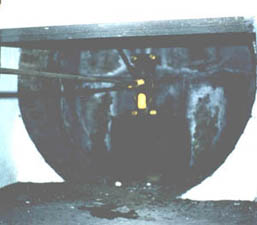
The five foot across hole which had held the astronomical dial was boarded up.
In 1835 King William IV commissioned Vulliamy's son, Benjamin Lewis Vulliamy to make new clocks for both St. James's and Hampton Court. St. James's clock was installed but the plans for the Hampton Court clock were lost.
In 1879, the remains of the astronomical dial - its three copper rings, were discovered lurking in a storeroom at the palace.
The Board of Works commissioned Gillet and Bland of Croyden to make a new clock to drive both the Vulliamy dial and the astronomical dial, which was to be restored: "to its original condition, the same as it was when put up in the year AD 1540." This is how the myth that the clock dated from 1540 came about, based on Derham's observations. And how "AD 1540" came to be engraved on a bar of the dial.
The clock was installed in March 1880. It has a double-three-legged gravity escapement, with a remontoire. More details can be found in "Inside the Hampton Court Clock". Since then the clock (but not the clock room) was been maintained, repaired and cleaned a number of times. In 1975 an electrical winding system was installed, making the weights redundant. This meant no one had to climb up the steep spiral staircase twice a week to wind the clock, and therefore the clock was no longer receiving regular care and attention.
Our work on the clock was aided by the fact that we were able to investigate the clock tower when that part of the palace was awaiting restoration and therefore could see far more of the structure and the changes that had been made. We were given copies of old plans of the palace. We also found useful information in accounts and other records and in books. And we have been helped by a number of people. More references and acknowledgments in the booklet, now downloadable free.
More information, illustrations, references, on the history of the Hampton Court Clock, can be found in this booklet: Inside the Hampton Court Clock, by Heather Hobden, ISBN: 9781871443141,now available as free download (see list at side). By the author of the original official guides, this contains all the interesting information that was omitted in the original guide and more detail than the website.
Feedback, inquiries, contact us at: post@cosmicelk.net.
| This website written, designed and maintained by Heather Hobden | The Cosmic Elk |